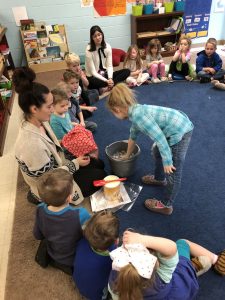Melting Ice and Salt: We sprinkled a handful of salt over a block of ice, immediately the students started to notice the ice melting and rivets appear. Then, we added droplets of food coloring all over the top of the ice and salt. The food coloring started to highlight the patterns, tunnels and rivets the salt had created. The students learned that the salt lowered the freezing point of the water. Therefore, the ice started to melt, as the ice melted, energy was drawn from the water making it colder.



Blubber Glove: We made a blubber glove so we could get a better understanding of why polar animals can be exposed to the frigid Arctic and Antarctic waters. First, each child had the chance to put their hand in a bucket of ice water. Then, each child had the chance to put their hand in a bucket of ice water wearing the blubber glove (Crisco between two gallon sized Ziploc bags). We discovered that the blubber on the polar animals helps to insulate them, because blubber requires very little blood supply, allowing more blood to be circulated to skin surfaces that are more directly exposed to the cold temperatures.




